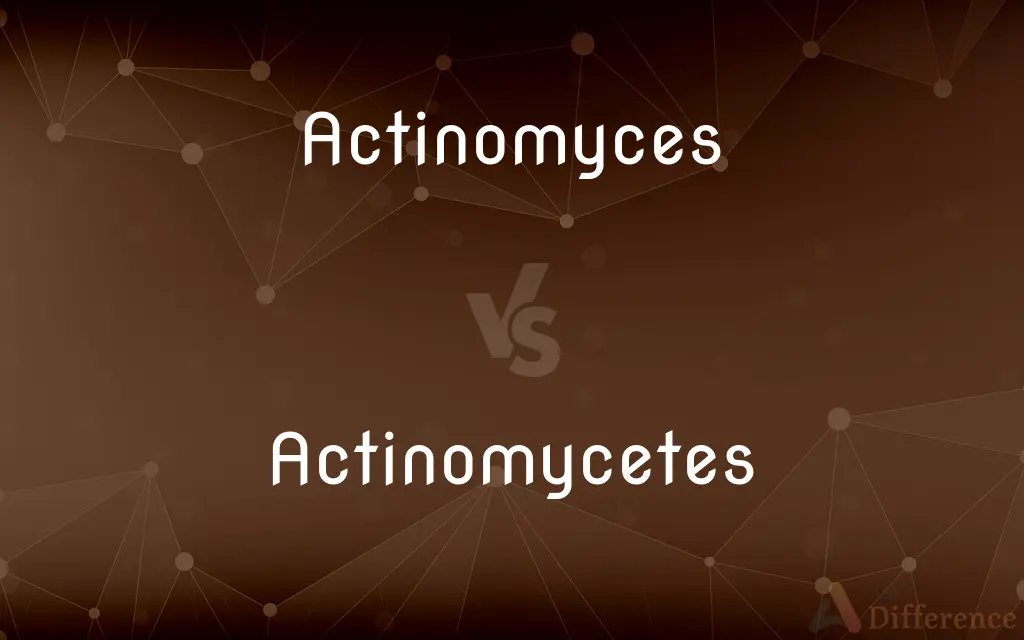Actinomyces vs. Actinomycetes — What's the Difference?
By Maham Liaqat & Urooj Arif — Updated on March 16, 2024
Actinomyces are bacteria known for causing disease in humans, while actinomycetes are a broader group of bacteria, including soil organisms that produce antibiotics.

Difference Between Actinomyces and Actinomycetes
Table of Contents
ADVERTISEMENT
Key Differences
Actinomyces is a genus of bacteria that are part of the normal flora of the mouth and throat but can cause diseases such as actinomycosis when they invade human tissues. Actinomycetes, on the other hand, refer to a broader classification of gram-positive bacteria, including both pathogenic and non-pathogenic species found in various environments like soil, where they play a crucial role in organic matter decomposition and produce antibiotics like Streptomycin.
Actinomyces species are typically characterized by their ability to form branching filaments, somewhat resembling fungi in structure, which is a trait that they share with many actinomycetes. However, whereas actinomycetes are known for their diverse roles in natural ecosystems and industrial applications, Actinomyces primarily garners attention for its clinical significance.
The pathogenicity of Actinomyces involves the formation of abscesses and sinus tracts, often following dental procedures or oral infections. Actinomycetes, while including some pathogenic species, are more celebrated for their beneficial roles, such as antibiotic production and contribution to the nitrogen cycle, highlighting their importance in both natural environments and biotechnology.
Actinomyces infections are treated with antibiotics, requiring long-term therapy due to their tendency to form dense clusters of organisms in host tissues. In contrast, the study and utilization of actinomycetes focus on harnessing their antibiotic-producing capabilities to combat a wide range of bacterial infections, underscoring the dual nature of bacteria as both pathogens and invaluable resources in medicine.
Despite their similarities, the distinction between Actinomyces and actinomycetes lies in their ecological roles, pathogenic potential, and economic importance. Actinomyces's role in human disease contrasts with the broader group of actinomycetes' critical contributions to environmental sustainability and pharmaceutical innovation.
ADVERTISEMENT
Comparison Chart
Classification
Genus within the Actinomycetes
Broad group of gram-positive bacteria
Habitat
Human oral cavity, can cause infection
Soil, water, and various environments
Role
Primarily known for pathogenicity
Decomposition, antibiotic production
Disease Association
Actinomycosis, characterized by abscesses and sinus tracts
Some species are pathogenic, but many have beneficial roles
Industrial Use
Limited, mostly of clinical interest
Widely used in antibiotic production and biotechnology
Compare with Definitions
Actinomyces
A genus of bacteria that form part of human oral flora and can cause diseases.
Actinomyces israelii is a well-known species causing actinomycosis.
Actinomycetes
Found in soil, freshwater, and marine environments, contributing to nutrient cycling.
Actinomycetes are crucial for breaking down complex organic compounds in soil.
Actinomyces
Forms branching filaments that can resemble fungal infections.
Histological examination of infected tissues often shows characteristic sulfur granules.
Actinomycetes
Enhance soil fertility and support the decomposition of organic materials.
Actinomycetes contribute to the natural recycling of plant and animal matter.
Actinomyces
Can cause invasive infections in humans, particularly in the oral and facial regions.
Actinomyces infections often require surgical intervention and long-term antibiotic therapy.
Actinomycetes
Includes decomposition of organic matter and production of antibiotics.
Actinomycetes play a vital role in soil health and agricultural productivity.
Actinomyces
Primarily found in the human oral cavity and respiratory tract.
Poor dental hygiene can increase the risk of Actinomyces-related infections.
Actinomycetes
A broad group of gram-positive bacteria known for their filamentous growth and diverse roles in nature.
Streptomyces, a genus of actinomycetes, is a major source of antibiotics.
Actinomyces
Noted for its ability to cause serious but treatable infections in humans.
Actinomyces species are a significant concern in oral and maxillofacial infections.
Actinomycetes
Key producers of antibiotics and other pharmaceutical compounds.
The discovery of Streptomycin from actinomycetes revolutionized the treatment of tuberculosis.
Actinomyces
Any of various rod-shaped or filamentous, chiefly anaerobic bacteria of the genus Actinomyces, commonly found in the mammalian oral cavity and including pathogenic species, such as the causative agents of actinomycosis.
Actinomycetes
Any of various spore-forming, chiefly filamentous bacteria of the order Actinomycetales that are abundant in soil. Some species produce natural antibiotics, and some are human pathogens.
Actinomyces
Actinomyces is a genus of the Actinobacteria class of bacteria. They all are Gram-positive.
Actinomycetes
Plural of actinomycete
Actinomyces
A bacterium (species) of the genus Actinomyces.
Actinomycetes
Branched gram-positive bacteria, often found in soil, some of which are pathogenic for humans and animals.
Actinomyces
Soil-inhabiting saprophytes and disease-producing plant and animal parasites
Common Curiosities
What are some beneficial roles of actinomycetes?
They play a key role in decomposing organic material and producing over two-thirds of clinically useful antibiotics.
How are Actinomyces infections treated?
Treatment typically involves long-term antibiotic therapy and sometimes surgical intervention to remove infected tissues.
Can actinomycetes cause diseases?
While some actinomycetes can be pathogenic, many are beneficial and are not typically associated with human diseases.
How do Actinomyces species become pathogenic?
They can invade human tissues following disruptions in mucosal barriers, such as dental procedures or trauma, leading to infection.
What role do actinomycetes play in the environment?
They are crucial for nutrient cycling, soil health, and decomposing complex organic materials.
What differentiates Actinomyces from actinomycetes?
Actinomyces is a specific genus known for causing human diseases, while actinomycetes encompass a broader group of bacteria with diverse roles, including antibiotic production.
Can actinomycetes be found in water?
Yes, actinomycetes can inhabit freshwater and marine environments, contributing to the decomposition of organic matter.
Why are actinomycetes important in biotechnology?
Their ability to produce antibiotics and other secondary metabolites makes them invaluable in pharmaceuticals and agriculture.
Are all Actinomyces species harmful to humans?
While not all species are pathogenic, some, like Actinomyces israelii, are known to cause infections in humans.
How do scientists utilize actinomycetes in antibiotic production?
Researchers isolate and culture actinomycetes from natural environments to discover and produce new antibiotics.
What makes actinomycetes unique among bacteria?
Their ability to form branching filaments and produce a wide range of bioactive compounds sets them apart from other bacteria.
How are new actinomycetes strains discovered?
Scientists explore diverse environments, from soil to marine sediments, to isolate and identify new strains with potential industrial applications.
What distinguishes the filamentous growth of Actinomyces from fungi?
Although Actinomyces form filamentous structures, they are bacteria with distinct cellular and genetic characteristics compared to fungi.
How do Actinomyces infections manifest in the body?
Infections typically present as chronic, slowly progressing abscesses and sinus tracts, often requiring medical intervention.
What is the significance of antibiotic-producing actinomycetes in modern medicine?
They are a cornerstone in the treatment of bacterial infections, with their antibiotics being vital to combatting a range of diseases.
Share Your Discovery

Previous Comparison
Reality vs. Actuality
Next Comparison
Artisan vs. CraftsmanAuthor Spotlight
Written by
Maham LiaqatCo-written by
Urooj ArifUrooj is a skilled content writer at Ask Difference, known for her exceptional ability to simplify complex topics into engaging and informative content. With a passion for research and a flair for clear, concise writing, she consistently delivers articles that resonate with our diverse audience.














































